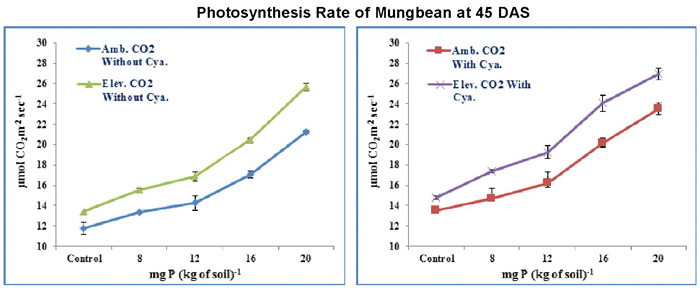| Follow @co2science |
Paper Reviewed
Dey, S.K., Chakrabarti, B., Prasanna, R., Singh, S.D., Purakayastha, T.J., Datta, A. and Pathak, H. 2017. Productivity of mungbean (Vigna radiata) with elevated carbon dioxide at various phosphorus levels and cyanobacteria inoculation. Legume Research 40: 497-505.
Writing as background for their study, Dey et al. (2017) note that phosphorus (P) "plays an important role in N-fixation in legumes by supplying energy to the plant at the time of reduction of atmospheric nitrogen (N) in plant root nodule," and they opine that, given the growth-enhancing benefits of atmospheric CO2 on such plants, there may be an increased demand for P under elevated CO2 conditions in order for legumes to more fully harness the benefits of N fixation. In a test of this hypothesis, therefore, the team of seven Indian researchers set out to investigate the impact of elevated CO2 and phosphorus on the growth and yield of mungbean (Vigna radiata) crop.
Their work was conducted at a Free Air Carbon Dioxide Enrichment (FACE) facility at the Indian Agricultural Research Institute in New Delhi, India, where mungbean was grown in pots both within and without the FACE rings. Atmospheric CO2 levels included control (400 ppm) and elevated (550 ppm) and P was applied in five doses (0, 8, 12, 16 and 20 mg P kg-1 soil, which correspond to a control and 75%, 100%, 125% and 150% of the recommended dose of P). In addition, the scientists added a third variable to their experimental setup -- the presence or absence of cyanobacterial (Calothris sp.) seed inoculation. Cyanobacteria are photosynthetic, nitrogen-fixing bacteria and their application has been shown to benefit plant growth. As such, Dey et al. determined to investigate the effects of this variable on mungbean growth as well. And what did the experiment reveal?
Elevated CO2 alone had a stimulatory effect on leaf area, photosynthesis rate (see Figure 1 below), leaf chlorophyll content, number of pods per plant, number of seeds per pod, which contributed to an average increase in biomass yield of 31.3% and seed yield of 35.0%. The application of P and cyanobacterial inoculation further increased crop growth and yield, which cumulative findings led the authors to conclude that "at high CO2 concentration, [the] application of P nutrient, as well as cyanobacteria, could help in further improvement of growth and productivity of legumes."

Figure 1. Interactive effect of elevated CO2, cyanobacterial inoculation and phosphorus doses on the photosynthetic rate of mungbean at 45 days after sowing (DAS). Adapted from Dey et al. (2017).




